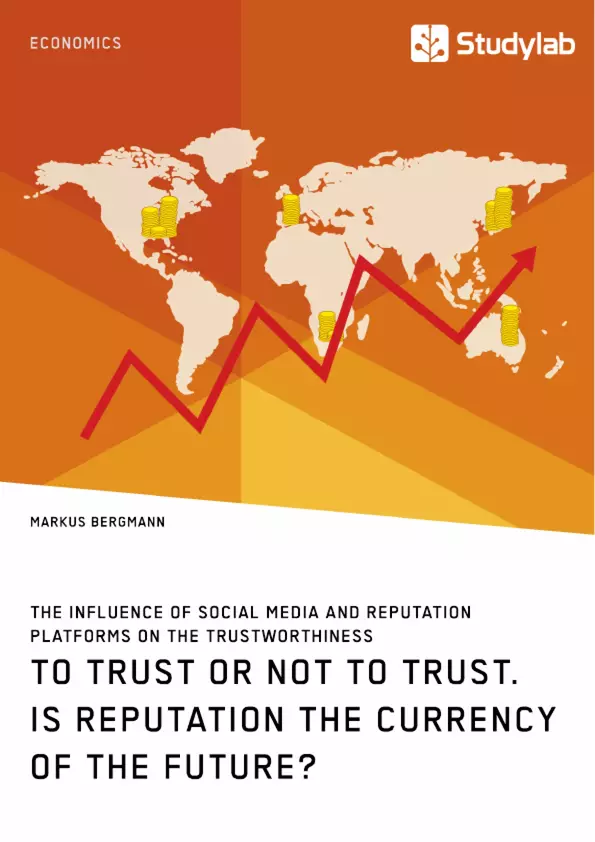In the past, trust was bound to personal relationships and trustworthy institutions. Nowadays sharing economy companies rely on reputation systems for decentralized trust. Profiles and ratings are replacing collaterals and institutional trust.
Reputation platforms like Traity aggregate data from different sources like social media and calculate a score that expresses the trustworthiness of a person. In his publication, Markus Bergmann examines an important question: Which influence do the information from social media and reputation platforms have on the assessment of strangers in peer-to-peer transactions?
Bergmann therefore simulated a survey with about 100 participants in which the trustworthiness of potential tenants was rated. He focusses on peer-to-peer room rental. But his results generally show to which extend companies and individuals can influence their trustworthiness via Facebook and Traity profiles.
In this book:
- Trust;
- Reputation;
- Scoring;
- Deposit;
- Trustworthiness;
- Sharing Economy
Table of Contents
- Abstract
- List of Abbreviations
- List of Figures
- List of Tables
- 1 Introduction
- 2 Theoretical Background
- 2.1 Trust
- 2.2 Sharing
- 3 Hypotheses Development
- 4 Methodology
- 4.1 Research Model
- 4.2 Sampling
- 4.3 Sample Size
- 4.4 Survey Design
- 4.5 Pretest
- 4.6 Main Study
- 5 Analysis and Results
- 5.1 Extract, Transform and Load
- 5.2 Sample
- 5.3 Quantitative Analysis
- 5.4 Qualitative Analysis
- 6 Conclusion
- 6.1 Limitations
- 6.2 Practical Implications
- 6.3 Further Research
- Bibliography
Objectives and Key Themes
This study investigates the influence of social media and reputation platforms on trustworthiness perceptions in peer-to-peer transactions, particularly within the context of the sharing economy. The work aims to quantify the impact of Traity, a reputation platform, on trustworthiness assessments, using a simulated room rental scenario. The study utilizes a survey with 104 participants, examining different levels of information, from an e-mail only inquiry to a Traity reputation score.
- Trust and its evolution in the digital age, especially in the sharing economy.
- The role of reputation systems and platforms like Traity in fostering trust.
- The influence of social media and reputation platforms on trustworthiness perceptions.
- Quantitative and qualitative analysis of the impact of Traity on trustworthiness assessments in a peer-to-peer room rental scenario.
- The relationship between reputation and the perceived need for traditional security measures like deposit payments.
Chapter Summaries
- Chapter 1: Introduction This chapter introduces the topic of trust in the context of the sharing economy and the increasing reliance on reputation platforms. It outlines the research problem, focusing on the influence of social media and reputation platforms on trustworthiness perceptions in peer-to-peer transactions.
- Chapter 2: Theoretical Background This chapter delves into the theoretical framework, exploring the concept of trust and its evolution in the digital age. It discusses the role of sharing economy platforms and reputation systems in fostering trust and building relationships.
- Chapter 3: Hypotheses Development This chapter formulates hypotheses based on the theoretical framework, outlining the expected influence of social media and Traity reputation scores on trustworthiness perceptions and deposit demands in a simulated room rental scenario.
- Chapter 4: Methodology This chapter details the research methodology employed in the study. It describes the research model, sampling procedures, sample size, survey design, pretesting process, and the main study itself.
- Chapter 5: Analysis and Results This chapter presents the analysis of the data collected through the survey. It outlines the data extraction, transformation, and loading processes, describes the sample characteristics, and presents the results of both quantitative and qualitative analyses.
Keywords
The study focuses on the relationship between trust and reputation, specifically exploring how social media and reputation platforms influence trustworthiness perceptions in peer-to-peer transactions. Key concepts include reputation scoring, deposit requirements, trustworthiness assessments, and the impact of Traity on these factors within the sharing economy context.
- Quote paper
- Markus Bergmann (Author), 2018, To Trust or Not to Trust. Is Reputation the Currency of the Future?, Munich, GRIN Verlag, https://www.grin.com/document/442456



